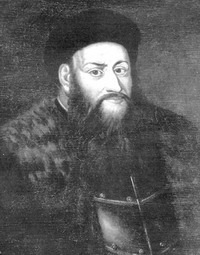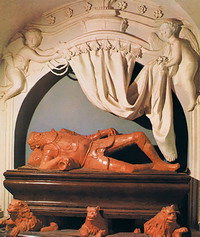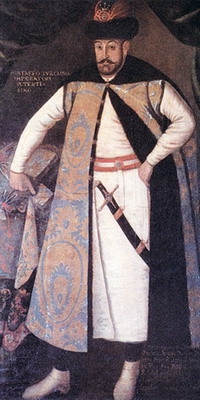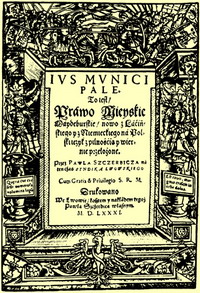social order and economic life in Ukraine in the second half of 1914 - early 16 th century.
Plan presentation
- leading role of the nobility as the top Ukrainian society at that time in political life.
- Ukrainian church and the state of the clergy.
- situation of Ukrainian peasants.
- Strengthen exploitation and restriction of personal liberty peasants.
- Social performances peasants.
- growth of cities, Magdeburg right.
Timeline
|
approx. 1460 - 1530 рр. |
years of life of Prince Konstantin Ivanovich Ostrozhskogo |
|
1458 |
final division of the Kyiv Metropolis of Kiev and Moscow |
|
1435 |
first known documents, which started many Ukrainian peasants enslavement |
|
1490 |
peasant uprising in Galicia and Bukovina under the Flies |
|
1356 |
Provision of Magdeburg law lions |
basic concepts and terms
nobility - birth Ukrainian nobility, aristocracy. Word gentry denotes a group of people known and well-born. The nobility was the tip of the society and its elite. For many centuries served as the political leader of the Ukrainian people, an exponent and defender of its national interests. Representatives of the groups carried out the political leadership, asked certain political goals have contributed to the culture and education, supported the church and the people fed sense of national identity.
tycoon - the most powerful and influential landowners, mostly princes.
shop was a self-governing community of free artisans of one or more specialties, headed by elected officers - Tsehmistro. Besides artists, the shop assistants were their - apprentices (comrades) and students (condyle, boys). Each shop had its written charter, approved by the king or the owner of the private city. Charter defined as features of production and general lifestyle artisans.
Magdeburg Law - right which the city rid of court administration and the big landowners and created local governments like the German city of Magdeburg .
Serfdom - system of legal norms that establish the dependence of peasants on feudal lord. Serfdom included to attach themselves to the land of peasants, feudal law to labor and peasant property, the alienation of his land as well without it, depriving peasants the right to dispose of immovable property, inheritance, to appear in court and others.
Voevoda led the notification and collection of noble militia of its territory, presided over dietine that it convened for selecting candidates for Zemskov governments; supervised prices, weights and measures in royal cities.
castellan (from «castellum» - «Castle, Castle») - administrator Castle District, which obeyed all local boyar-chivalrous person. Soon, its main functions will move to old age.
Filvarok (Polish folwark, from him. Vorwerk - farm, farm) - Poland, Lithuania, Ukraine and Belarus in 14-19 centuries. diversified economy, where raw materials are not only produced but also on pereroblyalasya distillery, tannery and in the mills. Based on the gratuitous labor of serfs. Products exported to markets manors. in the Ukrainian lands Filvarky was introduced in Galicia in 15 century. In most Ukrainian lands were part of Lithuania, filvarkova economic system began to be implemented from within. 16 cent.
Personality

 Konstantin I. Ostrozhsky (ca. 1460 - 1530) - one of the most respected representatives of the most powerful princely family, uncrowned king of Russia, then as saying. Traditionally, that has reached the Kievan Rus, and by vocation, he took care of the Orthodox church and cultural life. However, most were famous as a commander. Contemporaries portrayed him as small in stature and physique plain, humble and unpretentious. But if Duke Konstantin perevtilyuvavsya on the battlefield - where he was unflappable and neshytnym as expected knights. Very brave, he did not lose sanity at the hottest moments and skillfully managed the Army. So do not accidentally prince was a favorite of King Polish-Lithuanian state Sigismund, who showered his honors and titles. Polkovodnytska Ostrozky career began after defeating enemies in 90 years. Year 1497 he became governor of castle in the winery and Bratslav, taking intoidpovidalnist for defense against attacks Krimchaks. In the same year he led the armed forces of the Great Duchy of Lithuania - it was hetman. During the battle of Moscow army in 1500 on the river Vedroshi Siversky captured. A few years was in exile, but soon returned home. Vedroshivsku wages of defeat was the Battle of Orsha in 1514 in which Ostrozhsky won a convincing victory.
Konstantin I. Ostrozhsky (ca. 1460 - 1530) - one of the most respected representatives of the most powerful princely family, uncrowned king of Russia, then as saying. Traditionally, that has reached the Kievan Rus, and by vocation, he took care of the Orthodox church and cultural life. However, most were famous as a commander. Contemporaries portrayed him as small in stature and physique plain, humble and unpretentious. But if Duke Konstantin perevtilyuvavsya on the battlefield - where he was unflappable and neshytnym as expected knights. Very brave, he did not lose sanity at the hottest moments and skillfully managed the Army. So do not accidentally prince was a favorite of King Polish-Lithuanian state Sigismund, who showered his honors and titles. Polkovodnytska Ostrozky career began after defeating enemies in 90 years. Year 1497 he became governor of castle in the winery and Bratslav, taking intoidpovidalnist for defense against attacks Krimchaks. In the same year he led the armed forces of the Great Duchy of Lithuania - it was hetman. During the battle of Moscow army in 1500 on the river Vedroshi Siversky captured. A few years was in exile, but soon returned home. Vedroshivsku wages of defeat was the Battle of Orsha in 1514 in which Ostrozhsky won a convincing victory.
zvytyazhtsya glory in the fight against the horde brought Duke Battle Vyshnivets in Volhynia in 1512 (freed from captivity one thousand prisoners) and on the river Krekhiv in Kyiv region in 1527 after winning Ostrozhskogo Krekhiv King arranged for Prince gala banquet in Krakow.
eloquently about the role of Prince Constantine in the history of the then Grand Duchy of Lithuania and the fact that by the end of his life he was at the highest governmental positions: a hetman, Vilnius and Trakai kashtelian locks. None of the Ukrainian princes never reached in the Grand Duchy of Lithuania the situation. According to researchers, the prince was the fourth man of wealth in the country and had about 60 thousand subjects.
main presentation
1. The leading role of the nobility as the top Ukrainian society in the political life of that time
-
 After Krevsk Union, and especially after defeats Svydrygailo Olgerdovich many Ukrainian and Belarusian princes lost their portions.
After Krevsk Union, and especially after defeats Svydrygailo Olgerdovich many Ukrainian and Belarusian princes lost their portions.
There was a gradual convergence - princely groups with other privileged states and consequently the single privileged status - the nobility.
- the middle of 15 century. in most Ukrainian lands confirmed the ruling of this structure: princes - lords - zem'yany-Gentry - Gentry-Golota - armor boyars.
- This structure continued until the mid 17 century.
However - dried out even princes were more likely to get high, governments in less than gentle, even and rich, Shlyakhtich.
- addition, the princes acted in public service to the Lithuanian, Polish and of keeping their principalities and receiving from state to private ownership and lifelong holding large land holdings.
Yes - princely families Ostrozkykh Vishnevetskih, Koretsky, Chortoryyskyh, Zbarazk occupied leading government positions in the Grand Duchy of Lithuania, sat on the board of the Great Prince, and the military marches were under their own flags.
Loss Ukrainian princes and state roles
- With the increasing influence of the Polish princes lost their ability at the state level to decide the fate of their homeland - she began to increasingly depend on the will of foreign capitals: Free or Krakow.
However - princely families still had power and authority to do local governance. Dividing each other first, Volhynia, and later, central Ukraine, they took real power on the ground.
- Their possessions prince acted with their own tax law and justice. It was his host.
- So at the local level, it seemed everything remained the same as and for the Middle Ages.
Actually, as representatives of princely families, their genealogies associated with the princes of Kievan Rus.
in the life of contemporary Ukraine occupied a special place Ostrozki family.
Lords and gentry: the fight for equal rights for all members of the aristocratic stratum
- to higher strata of contemporary Ukrainian society, but the princes belonged also gentlemen . The word « lord » in the 16 century. original title meant.
- Yes, and Kiev and Bratslavshchina first half of the 16 century. the 450 aristocratic families of aristocratic called about a hundred.
- main characteristic of master was that he owned a small though, but its own, grandfather-great grandfather, otchynnoyu land.
- As you know, even from the Kievan Rus had numerous stratum Knights boyars, who held the land-seniority - estates granted by the Grand Duke for military service.
- they saved for later times. But lord, unlike boyar who had to settle where the prince will give him the land was guaranteed hereditary ownership of land of their ancestors.
- largest number of layers was a layer of noble gentry - zem'yany .
- Some of them had the right to manage their own estates, which were their private property, the rest used the land subject to conscription.
- lost ground, these gentry came to the discharge noblemen Golota.
- distinguishing feature of life in Ukraine was that, despite the heterogeneity of the native, wanted to get the gentry stratum of shared rights and privileges, and thus ultimately separate from the rest of society.
- And if princes have those rights on the fact of his birth, the middle and petty nobility had their fight.
Changes in position - nobility reflected in legal codes of the time - charter Grand Duchy of Lithuania as amended in 1529 - First (or Old) Lithuanian Statute.
- Now the nobility was guaranteed that it can not be punished without trial.
- Act also provided the gentry land ownership, which could not select "no fault".
So, late 16 th century. Ukrainian nobility succeeded in securing legal right, which for centuries has gained a sword, carrying heavy military duty.
- to Galicia in the mid 15 th century. Galician boyars were equalized with the Polish gentry. This led to what is already in 16 century. land is left in the boyar families who would comply with Ukrainian traditions.
2. Ukrainian church and the state of the clergy
- As before a special place in Ukrainian society occupied the clergy, which constituted a separate social group.
According to researchers - spiritual condition was quite extensive, it belonged to almost one tenth of the population - with their families, priests, monks, people, serving the church.
- identity was revealed in the clergy that it was not subject to secular court.
Within 14 - 16 centuries. the Orthodox church and the clergy were not the same.
- In 14 century. Orthodox, Russians, faith was adopted by the Lithuanian prince.
- Authority Orthodox Church, which supported the majority of Ukrainian lands, remained quite high, however, the gradual spread of Catholicism among the grand court pressure from the Catholic state, which was Poland, has become increasingly stronger.
After - Krevsk Union of Orthodox Lithuanians and Lithuanians-pagans were gathered to Catholicism.
- boyars of Lithuania Catholics equalized the rights of the Polish gentry.
And - act that showed the division of society on religious grounds and opened the way for persecution of Orthodox, became Horodelska union in 1413, according to which participation in managing state and occupy government posts have the right to exclusively Catholics.
- However, certain guarantees of their position in the Ukrainian Orthodox were the aristocracy, whose members were constantly on the board of the Lithuanian Grand Duke and the highest positions.
- on Ukrainian territory, which was distributed to Polish administrative and political structure of the Orthodox church was difficult.
- characteristic feature of policy makers of the Grand Duchy of Lithuania, the Orthodox Church was to have within their states to deprive the church organization and church depends Muscovy.
- In the mid 15 th century. finally was divided Kyiv Metropolis of Kiev and Moscow.
- Cathedral Moscow bishops without approval from Constantinople made a separate metropolitan of Kiev remained a metropolitan Slave Patriarch of Constantinople.
And no matter how daunting was the Orthodox church, that it was the defender and representative of the Ukrainian and Belarusian people in the Catholic Polish-Lithuanian, Ukrainian and Belarusian center of culture and spirituality.
3. The state of Ukrainian peasants
- lowest point of the social pyramid, then the society sat the peasants who were the largest layer - up to 80% of the population.
- As before, the villagers living communities.
- Arable land divided between the parts of the community - yard , which brings together several «fumes» (yards), that economies of individual families.
- various taxes to the state and feudal village community also distributed among the yard.
- community elected their own courts. He was called shock from " digging" - a collection of the community.
Gradually - shock trial court was replaced by feudal lords themselves (patrimonial) and community land now owned by feudal lords.
- Historians conventionally divided villagers «a mortgage» (personally free) and «nepohozhyh» ( attached to their inheritance).
- addition, the nature of duties, among peasants distinguish, Danes, traction, servants.
- Danes - the largest group of "a mortgage" farmers - called those whose main duty was to pay tribute in kind or money for use ornymy lands and lands.
- Some villagers had to work in the household of his master with his «pulled» (ox and inventory), which serve serfdom.
- more privileged position among the peasants had servant , which are engaged in agriculture, while serving military service in the border castles. They took part in military campaigns, carried out various assignments.
4. Increased exploitation and restriction of personal liberty peasants
for 15 - early 16 th century. Ukrainian peasants in the life of significant changes took place, the essence of which was to limit personal freedom, the gradual enslavement.
- In those times in Ukraine take effect and continues to grow at a great feudal land tenure - magnate .
- It grew by Grand Duke talents, hobbies pustok, communal lands.
- the middle of 16 century. free land and communal land as free communities almost left.
- the second half of 15 century. unfolded grain production for sale in Western Europe.
- nobility of Galicia and Western Volyn starts laying Filvarky.
With the proliferation of manors - landowners were interested in working with farmers lordly estates «pulled» and limiting the rights of peasants switch. Number "nepohozhyh" peasants from increasing year by year.
- first known document that launched the enslavement of the peasants, the gentry considered decision of Galicia in 1435 for his peasant had a right to go to the landowner only for Christmas, paying him a large ransom.
- of Ukrainian lands in the Grand Duchy of Lithuania began zakripachuvaty peasants in 1447 in accordance with the privilege of Casimir IV.
- enslaving peasants were the bulk of that time stated in the Code of Laws - famous Lithuanian Statute (known to all three editions: 1529, 1566 and 1588). For The First Lithuanian Statute of the great privileges and Polish legislation, customary law strongly defended the interests of landowners, their legal status.
5. Social performances peasants
- Ukrainian peasants did not put up with the strengthening of social exploitation and fought against it, often beruchysya weapon.
- most important speech of this period was the uprising of the Ukrainian and Moldovan villagers Pokuttya and Northern Bukovina, part of Moldavia (1490-1492 biennium).
- Researchers stress that it was not only antisocial, but also liberating character, that had the goal not only improve the situation of peasants as a social stratum (reduction obligations), and pursue national liberation, as peasants were representatives of one nation and those in power & ndash ; more.
- In the ranks of the rebels, but the Ukrainian and Moldovan peasants and townspeople were even representatives of the Ukrainian Orthodox nobility.
Hiking - against Polish troops led fly.
- Year 1491 revived insurgency. The case continued predecessor Andrew Barula . But both peasants rebellions were quelled.
- his contribution to the fight against the oppressors did Transcarpathia and toilers who took part in the peasant war in Hungary in 1514 led doji.
6. The growth of cities
- the middle of 17 century. in the lands of Ukraine was around 1100 towns and cities. Although disputes about what constitutes the then city, among scientists not subside.
- One of the largest cities was Kyiv. In mid-17th century. Kyiv had about 10 thousand inhabitants.
- In the 16 century. Kremenets Bratslav and had about 5 thousand people, Luck - 4 thousand, Vladimir, Kiev, Zhitomir, Kano, jail for 2 to 4 thousand
- Among cities of Galicia, skirts and other Western Ukrainian lands were part of Poland, Lviv was the largest (according to calculations of scientists in the early 15 th century. - 10 thousand in the first half of 17 century. already 25-30 thousand).
- In the 16 century. Kamyanets had about 8 thousand people, Przemysl, Sanok - about 2 - 4tys.
- urban population consisted of urban elite (the rich merchant class, userers, guild masters), middle layer (wealthy burghers, merchants, craftsmen, apprentices) and the urban poor.
- In cities, especially in Galicia, residents, representatives of different nations. In Volyn and lands dominated central Ukraine Ukrainian.
Magdeburg Law
late 15 - early 16 th century. in Ukrainian cities spread Magdeburg law.
-
 Magdeburg law gave various economic benefits.
Magdeburg law gave various economic benefits.
Under this law - city magistrate ruled - a body that united council and bench .
- bench was headed by voit .
- Council headed burmystr .
- a magistrate chose the most respected burghers.
- Magdeburg Law was setting as the procedure of craft unions - shops.
Provide - Magdeburg Law was the privilege of Grand Duke of Lithuania or the Polish king, eventually received such a privilege in respect of their cities and tycoons.
- first mention of the urban distribution rights relating to Ukraine during the Galicia-Volyn principality 20's of 14 century.
- From the time of Prince George II Boleslav came to us on the charter mahdeburhiyu of Sanok in 1339
- In 1356 Magdeburg law has made Lions, later Kamianets Holm, Lutsk, Kyiv, Dubno, Rovno, Przemysl.
 English
English

 Konstantin I. Ostrozhsky (ca. 1460 - 1530) - one of the most respected representatives of the most powerful princely family, uncrowned king of Russia, then as saying. Traditionally, that has reached the Kievan Rus, and by vocation, he took care of the Orthodox church and cultural life. However, most were famous as a commander. Contemporaries portrayed him as small in stature and physique plain, humble and unpretentious. But if Duke Konstantin perevtilyuvavsya on the battlefield - where he was unflappable and neshytnym as expected knights. Very brave, he did not lose sanity at the hottest moments and skillfully managed the Army. So do not accidentally prince was a favorite of King Polish-Lithuanian state Sigismund, who showered his honors and titles. Polkovodnytska Ostrozky career began after defeating enemies in 90 years. Year 1497 he became governor of castle in the winery and Bratslav, taking intoidpovidalnist for defense against attacks Krimchaks. In the same year he led the armed forces of the Great Duchy of Lithuania - it was hetman. During the battle of Moscow army in 1500 on the river Vedroshi Siversky captured. A few years was in exile, but soon returned home. Vedroshivsku wages of defeat was the Battle of Orsha in 1514 in which Ostrozhsky won a convincing victory.
Konstantin I. Ostrozhsky (ca. 1460 - 1530) - one of the most respected representatives of the most powerful princely family, uncrowned king of Russia, then as saying. Traditionally, that has reached the Kievan Rus, and by vocation, he took care of the Orthodox church and cultural life. However, most were famous as a commander. Contemporaries portrayed him as small in stature and physique plain, humble and unpretentious. But if Duke Konstantin perevtilyuvavsya on the battlefield - where he was unflappable and neshytnym as expected knights. Very brave, he did not lose sanity at the hottest moments and skillfully managed the Army. So do not accidentally prince was a favorite of King Polish-Lithuanian state Sigismund, who showered his honors and titles. Polkovodnytska Ostrozky career began after defeating enemies in 90 years. Year 1497 he became governor of castle in the winery and Bratslav, taking intoidpovidalnist for defense against attacks Krimchaks. In the same year he led the armed forces of the Great Duchy of Lithuania - it was hetman. During the battle of Moscow army in 1500 on the river Vedroshi Siversky captured. A few years was in exile, but soon returned home. Vedroshivsku wages of defeat was the Battle of Orsha in 1514 in which Ostrozhsky won a convincing victory. After Krevsk Union, and especially after defeats Svydrygailo Olgerdovich many Ukrainian and Belarusian princes lost their portions.
After Krevsk Union, and especially after defeats Svydrygailo Olgerdovich many Ukrainian and Belarusian princes lost their portions. 
 Magdeburg law gave various economic benefits.
Magdeburg law gave various economic benefits. 



